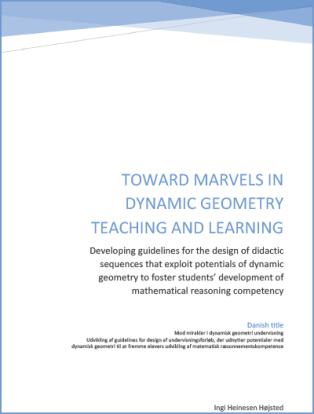Toward Marvels in Dynamic Geometry Teaching and Learning: Developing guidelines for the design of didactic sequences that exploit potentials of dynamic geometry to foster students’ development of mathematical reasoning competency
Synopsis
Digital technologies are gaining an increasingly prominent role in Danish primary and lower secondary school mathematics education. The expectations are that digital technologies can support students’ development of mathematical competencies. However, studies have demonstrated that the insertion of digital technologies into school mathematics does not automatically correspond to increased student learning outcomes (OECD, 2015). In fact, digital technologies can both produce marvels and cause disasters in mathematics teaching and learning (Niss, 2016). How digital tools are implemented seems to be essential. It is, therefore, a crucial research objective to unveil how didactic sequences may be designed for the efficient implementation of digital tools.
The overarching purpose of this dissertation is to identify guidelines for the design of didactic sequences that exploit potentials of dynamic geometry environments (DGEs) in relation to supporting students’ development of mathematical reasoning competency in Danish lower secondary school.
The dissertation consists of five papers and this summarizing report – which, altogether, seeks to shed light on the abovementioned purpose by first examining what the potentials of DGEs in relation to reasoning competency are according to previous mathematics education research (paper I) and then examining the extent to which these potentials are currently utilized in Danish lower secondary school (paper II). Based on these initial studies, guidelines are identified for the design of didactic sequences that utilize these potentials to support students’ development of mathematical reasoning competency (papers I, III, IV and V).
Methodologically, a mixed methods approach was applied with a qualitative priority. The quantitative data were collected from a web-based questionnaire that was developed and distributed to lower secondary school teachers. Anchored in design-based research methodology, the qualitative data were collected in connection with the design, testing and redesign of a didactic sequence in five different school classes. The data that were collected in the iterations of design are screencast recordings, videos, interviews, audio recordings and students’ written products.
The results from the project can coarsely be summarized as follows: In the review of mathematics education research, four DGE potentials were identified in relation to mathematical reasoning competency: dragging, feedback, measuring and tracing (paper I). The results of the survey indicate that these potentials are only exploited to a limited extent in lower secondary schools (paper II). The utilization of the potentials is described in guidelines that comprise a learning trajectory in terms of 5students’ cognition, task design and the role of the teacher. The a priori guidelines that are theoretically developed initially (paper I) are subsequently refined empirically based on the data that emerged in the design-based research (papers III, IV and V), leading to a posteriori guidelines (Chapter 5).
The dissertation was completed in the period 1 January 2018–31 December 2020.

